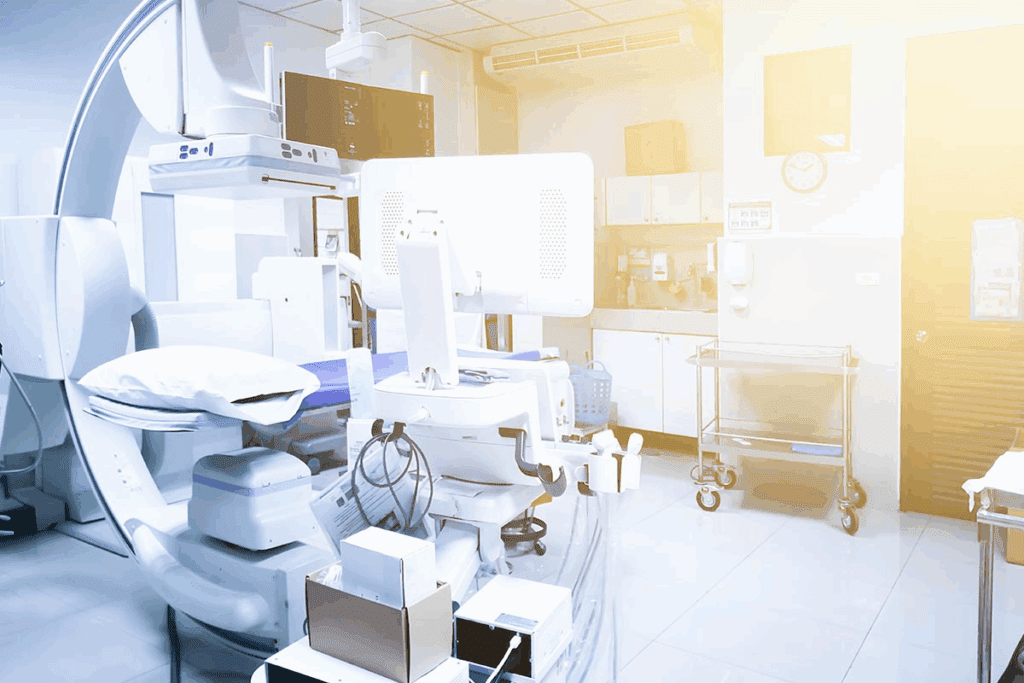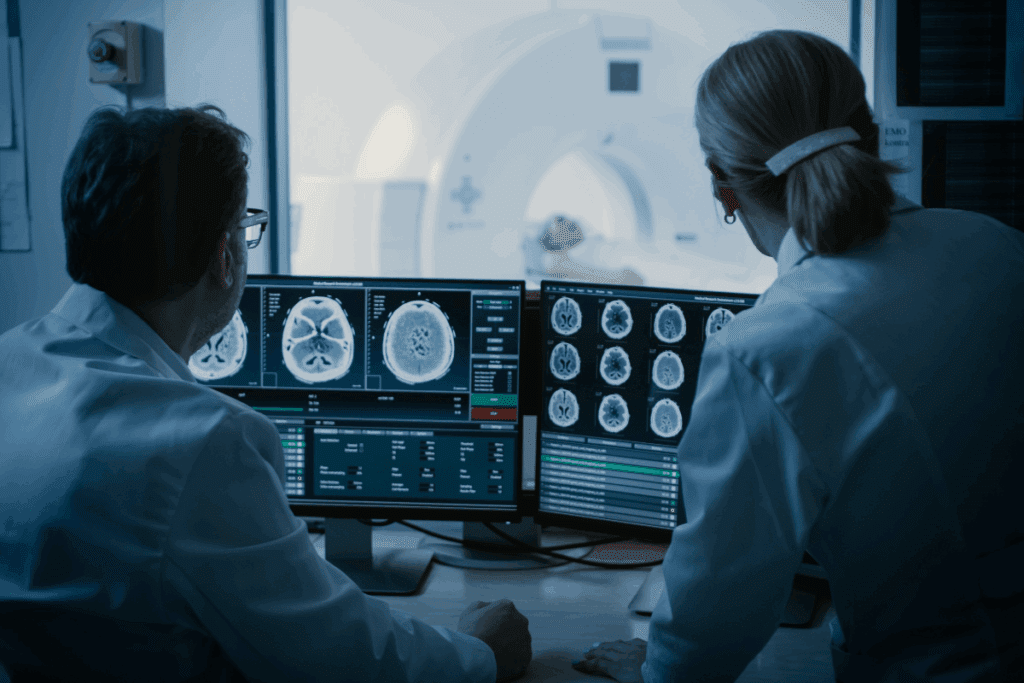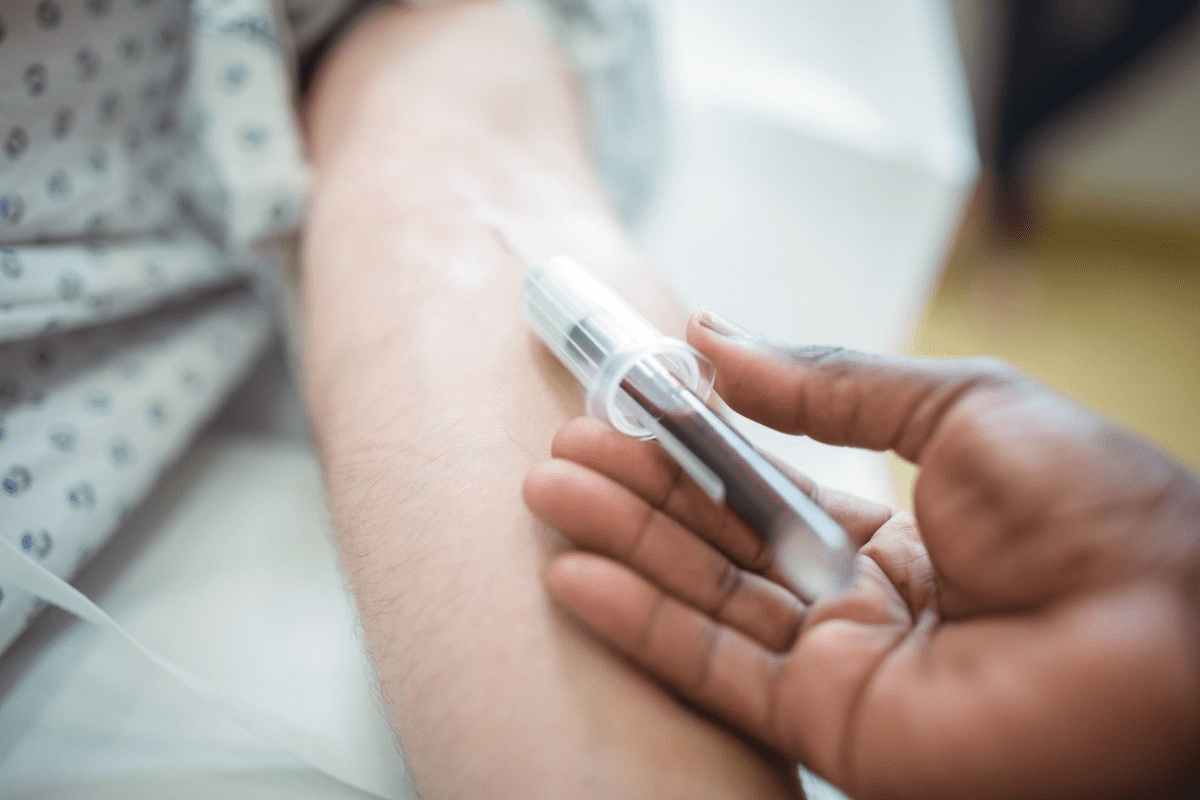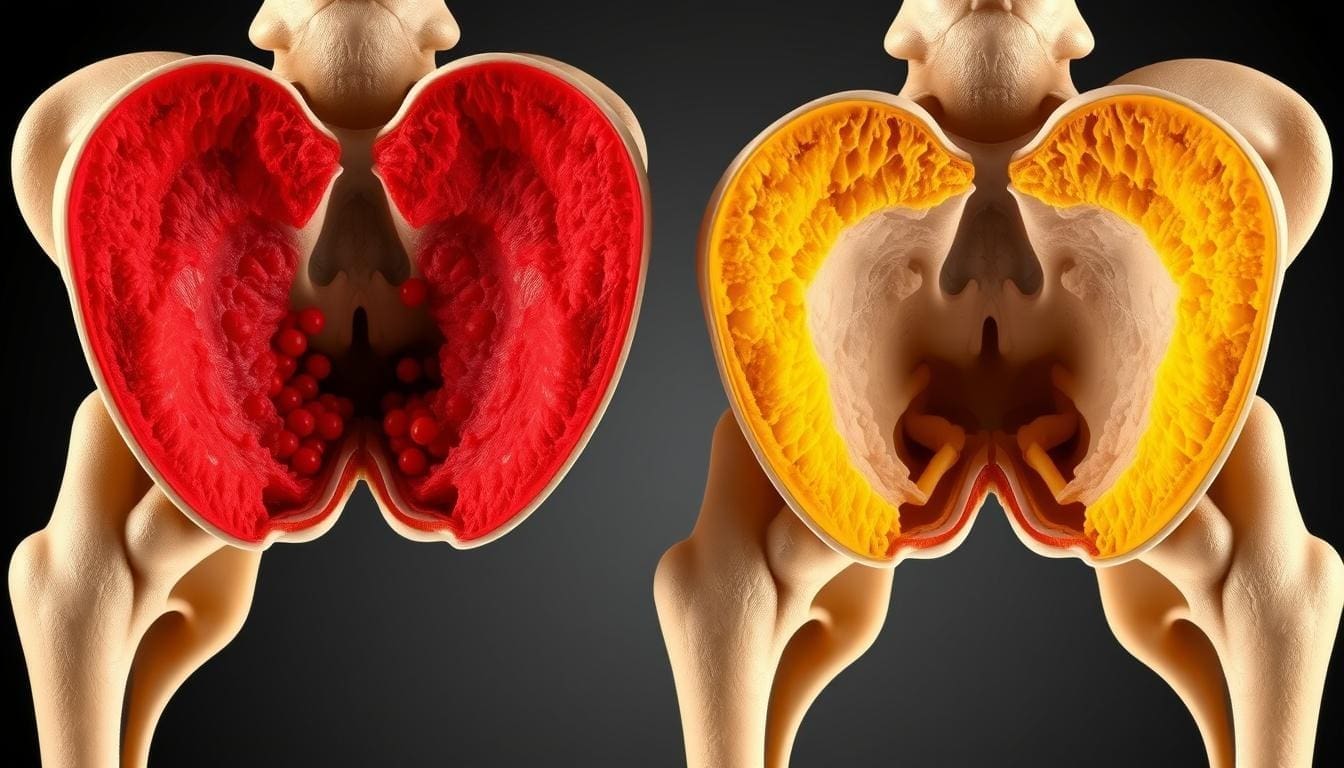Last Updated on November 26, 2025 by Bilal Hasdemir

We are changing hospital care with advanced IR suites for safety and efficiency. An IR suite is a special area in hospitals for doctors to do minimally invasive procedures. These procedures use medical imaging to find, treat, or cure many diseases.
At Liv Hospital, we focus on our patients to get the best results. We follow global best practices, making our IR suite key in modern healthcare. With the right equipment and a focus on safety, we help doctors give top-notch care.
Key Takeaways
- IR suites are dedicated areas for minimally invasive image-guided procedures.
- These procedures diagnose, treat, or cure various illnesses using medical imaging techniques.
- A patient-centered approach ensures optimal outcomes in IR procedures.
- Global best practices are essential for modern healthcare delivery.
- Specialized equipment and patient safety are critical components of an IR suite.
The Purpose and Significance of Modern Interventional Radiology

The interventional radiology (IR) suite is key in today’s healthcare. It allows for precise and effective treatments. IR changes patient care by using minimally invasive procedures.
Defining IR Procedures and Their Clinical Impact
IR procedures include many interventions like biopsies and embolizations. They also include central line placements and tumor ablation. These procedures have greatly improved patient outcomes.
Key benefits of IR procedures include:
- Minimally invasive techniques reducing tissue damage
- Less post-procedural pain and discomfort
- Shorter hospital stays and quicker return to normal activities
- Lower risk of complications compared to open surgery
The Evolution of Minimally Invasive Image-Guided Interventions
Interventional radiology has grown a lot over the years. This growth is thanks to better imaging and tools. Modern IR suites have top-notch imaging systems for precise guidance.
The integration of advanced imaging has been key in:
- Enhancing procedural accuracy
- Expanding the range of treatable conditions
- Improving patient safety through real-time monitoring
The IR suite is designed to be large, covering over 650 square feet. This space is needed for the complex equipment and team. The layout focuses on efficiency, safety, and being ready for emergencies.
Spatial Design and Layout of an Interventional Radiology Suite

Designing an interventional radiology suite is all about finding the right balance. We need to fit in IR equipment like biplane angiography systems and fluoroscopy units. This means considering both space and the need for advanced technology.
When designing the IR suite, we look at several key factors. These include the minimum space needed, the best room layout, and how to handle patient transport and emergencies.
Minimum Space Requirements
The suite should have at least 650 square feet of floor space. This size is essential for fitting in all the IR equipment and ensuring a smooth workflow.
A bigger room makes it easier for people and equipment to move around. This reduces the chance of problems during procedures.
| Room Dimension | Minimum Requirement | Recommended |
| Floor Area | 650 sq. ft. | 800 sq. ft. |
| Ceiling Height | 10 ft. | 12 ft. |
Optimal Room Configuration for Workflow Efficiency
The layout of the IR suite should help workflow flow smoothly. It’s important to have clear paths for moving patients and easy access to interventional biplane suite equipment.
We suggest placing the procedural table so it’s accessible from all sides. This way, there’s enough room for the biplane angiography system and other vital equipment.
Patient Transport and Emergency Access Considerations
Keeping patients safe is our top priority. The design of the IR suite must ensure easy patient transport and quick emergency access.
It’s important to think about where doors, corridors, and elevators are placed. This helps with fast patient transport and emergency access, keeping the area clean and controlled.
By planning the layout carefully, we can make the interventional radiology suite efficient. It supports smooth workflow, patient safety, and the best possible outcomes for procedures.
Advanced Imaging Systems: The Foundation of IR Capabilities
Advanced imaging systems are key to effective IR capabilities. They help us do complex procedures with great precision. IR procedures like biopsies and embolizations need top-notch imaging.
Biplane Angiography Systems for Complex Vascular Procedures
Biplane angiography systems are vital for complex vascular work. They show images from two angles at once. This is key for detailed views of blood vessels.
Key benefits include: better images, less contrast needed, and more accurate procedures.
High-Resolution Fluoroscopy Units
High-resolution fluoroscopy units are essential for IR procedures. They give clear views of tools and instruments in real-time. This helps place them accurately and avoids problems.
We use these units for many procedures, like vascular work and drainage.
Ultrasound Equipment for Real-time Guidance
Ultrasound is critical in IR for guiding procedures. It helps with precise needle placements and more. It’s very useful for biopsies and drainages.
Advanced ultrasound systems improve imaging. They include Doppler and contrast-enhanced ultrasound. These help check blood flow and tissue health.
In conclusion, advanced imaging systems are the heart of IR. With biplane angiography, high-resolution fluoroscopy, and ultrasound, we offer precise care to our patients.
Procedural Support Equipment and Monitoring Systems
Interventional radiology suites need advanced equipment and monitoring systems. These tools are key to keeping patients safe and procedures successful. They provide real-time data for quick, informed decisions by medical staff.
Anesthesia Delivery Systems and Integration
Anesthesia systems are vital in IR suites, giving patients the care they need during procedures. These systems must work well with the suite’s setup for safety. Advanced anesthesia delivery systems allow for precise control, essential for complex IR procedures.
Vital Signs Monitoring Technologies
Vital signs monitoring is critical in IR procedures. It lets doctors keep an eye on patients’ health in real-time. Advanced monitoring systems track important signs like heart rate, blood pressure, and oxygen levels.
Emergency Resuscitation Equipment Accessibility
Quick access to emergency equipment is essential in IR suites. In emergencies, fast access to tools like defibrillators and ventilators can save lives. IR suites must have readily accessible emergency resuscitation equipment.
In summary, the right equipment and monitoring systems are vital for IR suites. By using advanced anesthesia systems, vital signs monitoring, and ensuring emergency equipment is easy to reach, IR suites can offer top-notch care for complex procedures.
Radiation Safety Infrastructure in the IR Room
Radiation safety is key in a modern IR room. The room must be designed to keep patients and staff safe from radiation. This ensures a safe space for complex procedures.
Lead Shielding Requirements and Implementation
Lead shielding is vital for radiation safety in the IR suite. We must make sure all areas around the IR room are well shielded. This includes lead-lined walls, doors, and floors.
Key considerations for lead shielding include:
- Thickness and quality of lead lining
- Coverage area and shielding configuration
- Compliance with local and national radiation safety regulations
Radiation Dose Monitoring and Recording Systems
Tracking radiation doses is key for safety. We use advanced systems to monitor and record doses in real-time.
| Monitoring System | Description | Benefits |
| Real-time Dosimeters | Measure radiation dose in real-time during procedures | Immediate feedback for dose optimization |
| Radiation Dose Management Software | Records and analyzes radiation dose data | Long-term tracking and dose reduction strategies |
Personal Protective Equipment Storage and Accessibility
Personal protective equipment (PPE) is vital for staff safety. We make sure PPE is easy to find and stored well in the IR suite.
Proper PPE storage and accessibility involve:
- Strategic placement of PPE storage areas
- Regular inspection and maintenance of PPE
- Training staff on the correct use and handling of PPE
By adding these safety measures, we make the IR suite safer for everyone.
Environmental Control Systems for the Interventional Radiology Suite
The IR suite’s environmental control systems are key to quality patient care. They keep the area safe and efficient, vital for IR procedures.
Ventilation and Positive Pressure Requirements
Good ventilation in the IR suite is critical. It stops anesthetic gases and airborne contaminants from building up. We need a system that keeps positive pressure to keep the area sterile. This is done with air supply and exhaust systems that balance pressure.
A HEPA filtration system is also needed. It removes airborne pathogens and contaminants. This is essential for keeping the area sterile for IR procedures.
Temperature and Humidity Control Specifications
Keeping the temperature and humidity right is key for patient comfort and procedure success. The IR suite needs a climate control system. It should keep the temperature between 68°F to 73°F (20°C to 23°C) and humidity between 40% to 60%. This prevents equipment problems and keeps patients comfortable.
It’s also important to consider the needs of the imaging equipment. Some devices might need more specific temperature and humidity settings to work well.
Specialized Lighting for Procedural Accuracy
Good lighting is essential in the IR suite for precise procedures. We need specialized lighting that’s bright but doesn’t get too hot. LED lights are good because they’re cool, save energy, and can be adjusted for different procedures.
The lighting should also reduce glare and reflections on monitors. Adjustable lighting lets the team tailor the lighting for each procedure. This improves patient safety and procedure accuracy.
Specialized Furniture and Ergonomic Workstations
The interventional radiology (IR) suite needs specialized furniture and ergonomic workstations. These are key to efficient workflow and less fatigue. We focus on making the IR suite comfortable for both patients and staff.
Procedural Tables with Multi-directional Capabilities
Procedural tables in the IR suite must move in many directions. They support a wide range of procedures, from simple biopsies to complex vascular interventions. Advanced table designs help control patient positioning, making IR procedures more accurate.
Operator Control Consoles and Imaging Displays
Operator control consoles and imaging displays are vital in the IR suite. They allow for real-time image guidance and control over equipment. We focus on intuitive console designs to reduce fatigue during long procedures.
Staff Comfort Features for Extended Procedures
Staff comfort is key in the IR suite, where procedures can last a long time. Ergonomic design elements, like adjustable lighting and comfy seating, support a good work environment. We also value ergonomic accessories to reduce staff strain during long procedures.
By adding specialized furniture and ergonomic workstations, the IR suite improves for both patient care and staff well-being. This approach to design supports high-quality interventional radiology services.
Supply Management and Procedural Support Infrastructure
The IR suite’s success depends on its supply management and support systems. It’s key to manage supplies and equipment well. This ensures procedures are done safely and smoothly.
Inventory Systems for Specialized IR Equipment
Managing inventory is vital in the IR suite. We must have all needed equipment ready and easy to find. This includes:
- Angiography catheters and guidewires
- Stents and balloon catheters
- Embolization materials
- Biopsy needles and other sampling devices
An efficient inventory system helps track and manage these supplies. It prevents stockouts or overstocking. For example, barcode scanning can track inventory and automate orders.
| Equipment Type | Minimum Stock Level | Reorder Threshold |
| Angiography Catheters | 20 | 5 |
| Stents | 15 | 3 |
| Embolization Materials | 30 | 10 |
Medication and Contrast Media Management
Managing medications and contrast media is key for patient safety. We must ensure:
- Medications are stored correctly (e.g., at the right temperature).
- Contrast media are available and not expired.
- We have a system to track these supplies.
The Society of Interventional Radiology says, “The safe use of contrast media is vital in IR.”
“The safe administration of contrast media is a critical aspect of IR practice.”
Sterile Field Maintenance Solutions
Keeping the sterile field clean is essential for preventing infections. We do this by:
- Using sterile drapes and covers for equipment
- Following strict gowning and gloving protocols
- Making sure everyone knows and follows sterile techniques
By focusing on these areas, we can make our IR suite more efficient and safe. This leads to better patient care.
Conclusion: Integrating Technology and Expertise in the IR Environment
We’ve looked at what makes an interventional radiology (IR) suite key in today’s healthcare. These suites help doctors find and treat diseases with cutting-edge imaging. They work with other healthcare teams to give patients the best care possible.
In hospitals, knowing about IR is vital for top-notch patient care. IR suites have the latest tech, like advanced imaging and tools for procedures. This helps doctors do treatments that are less invasive.
As we move forward in interventional radiology, combining tech and expertise is key. This way, our IR suites stay at the top of healthcare. They ensure patients get the best care available.
FAQ
What is an IR suite in a hospital?
An IR suite is a special area in hospitals for image-guided procedures. It helps doctors diagnose and treat illnesses with advanced imaging. This makes treatments safer and more precise.
What are IR procedures?
IR procedures are non-invasive treatments guided by imaging. They include angiography, fluoroscopy, and ultrasound. These methods help diagnose and treat many conditions, reducing recovery time and improving health outcomes.
What is the significance of modern interventional radiology?
Modern interventional radiology has changed medicine a lot. It offers non-invasive treatments that are faster and safer. These treatments also give patients better results and fewer side effects than traditional surgery.
What is the minimum space required for an IR suite?
An IR suite needs at least 650+ square feet. This space is for the equipment, workflow, and safety of patients.
What kind of imaging systems are used in IR procedures?
IR uses advanced imaging like biplane angiography and high-resolution fluoroscopy. Ultrasound is also used. These tools help doctors perform precise and accurate treatments.
What is the importance of radiation safety in the IR suite?
Keeping patients and staff safe from radiation is key in the IR suite. This includes using lead shielding, monitoring radiation doses, and wearing protective gear.
What environmental control systems are essential for the IR suite?
The IR suite needs special systems for air, temperature, humidity, and lighting. These systems keep the environment safe and efficient for everyone.
What kind of furniture and workstations are used in the IR suite?
The IR suite has special furniture and workstations. These include tables, consoles, and comfort features. They help staff work efficiently and avoid getting tired.
How is supply management handled in the IR suite?
Managing supplies in the IR suite is important. It includes systems for equipment, medications, and maintaining a sterile environment. This ensures smooth workflow and patient safety.
What is the role of anesthesia delivery systems in IR procedures?
Anesthesia systems are vital in IR procedures. They provide safe anesthesia care for patients undergoing treatments. This ensures patients are comfortable and safe during the procedure.
What is an interventional biplane suite?
An interventional biplane suite is a special IR suite. It has biplane angiography systems for complex vascular procedures. This allows for precise and accurate treatments.
What does IR mean in a hospital?
IR stands for Interventional Radiology. It’s a medical field that uses imaging to guide non-invasive treatments. This helps diagnose and treat many conditions.
References
Peng, J., et al. (2024). Systematic review and meta-analysis of current evidence in uterine artery embolization compared to myomectomy on symptomatic uterine fibroids. Scientific Reports, 14, Article 12345. https://www.nature.com/articles/s41598-024-69754-0






